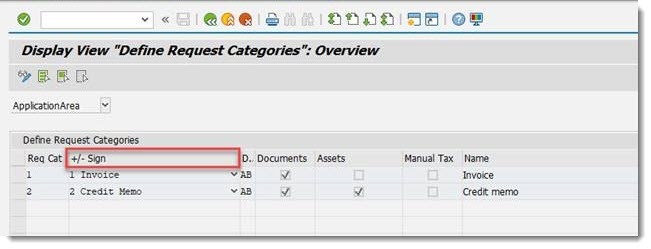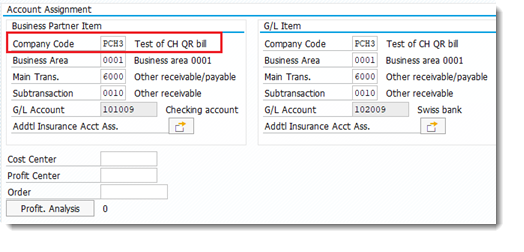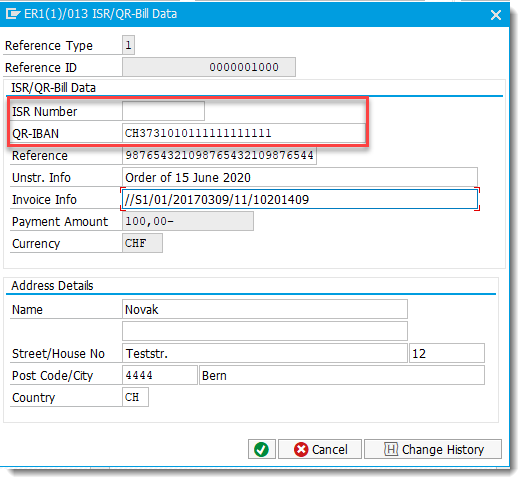
- SAP Community
- Products and Technology
- Enterprise Resource Planning
- ERP Blogs by SAP
- QR-Bill in Contract Accounting and Collections and...
Enterprise Resource Planning Blogs by SAP
Get insights and updates about cloud ERP and RISE with SAP, SAP S/4HANA and SAP S/4HANA Cloud, and more enterprise management capabilities with SAP blog posts.
Turn on suggestions
Auto-suggest helps you quickly narrow down your search results by suggesting possible matches as you type.
Showing results for
former_member25
Explorer
Options
- Subscribe to RSS Feed
- Mark as New
- Mark as Read
- Bookmark
- Subscribe
- Printer Friendly Page
- Report Inappropriate Content
05-26-2020
3:51 PM

QR-bill is replacing the existing multiplicity of payment slips in Switzerland and so is helping to increase efficiency and simplify payment traffic, at the same time offering a way of dealing with the challenges presented by digitalization and regulation. The new bills contain all the payment information in a QR code and can simply be scanned digitally.
The QR-bill will replace the current orange and red Swiss ISR (Inpayment Slips with Reference Number) starting on June 30, 2020.
This blog post helps you understand the solution regarding the QR-bill for FI-CA and FS-CD.

Customizing for QR-bill
QR-Bill Reference
QR-bill can be in three different versions:
- QR-IBAN with QR reference
The QR-IBAN is the International Bank Account Number (IBAN) that identifies the supplier's international bank account number that is used during a payment transaction. The QR-IBAN contains the QR-IID (bank identification) in positions 5-9, using a number range from 30000 through 31999. QR-IBAN must be used for payments with a structured reference. The formal structure of this IBAN corresponds to the rules defined in ISO 13616.
The QR reference type is a 27-digit reference. This reference type follows the same rules as the former ISR reference. Position 27 contains a check digit according to modulo 10 recursive. It can be used with a QR-IBAN (IID 30000-31999) only.
- Standard IBAN without a reference
If you choose this reference type, no reference will be created. You can use this reference type with a standard IBAN, not with a QR-IBAN.
- Standard IBAN with ISO creditor reference
The ISO creditor reference type is a maximum 25-digit reference generated according to ISO 11649. The reference starts with 'RF', then followed by 2 check digits, and then maximum 21 characters - altogether maximum 25 characters. You can use this reference type with a standard IBAN, not with a QR-IBAN. ISO 11649 reference can be used internationally.
Enabling QR-bill functionality
To enable QR-bill functionality, customize the system as explained below.
In Customizing for Financial Accounting under Financial Accounting Global Settings > Global Parameters for Company Code > Maintain Additional Parameters.


There is a new parameter type CHQR for Switzerland available. For this parameter type, enter parameter values as follows:
| «empty» | ISR only |
| B | Both, ISR number and QR-IBAN Note: this option will be used in the transition period when both ISR Number and QR-IBAN will be allowed |
| Q | QR-IBAN only |
When You Use the ISR Subscriber Number Only
When the parameter CHQR is empty, only the ISR subscriber number can be entered. While it was not possible in the past, the additional info can now also be used for the ISR procedure.
- ISR number and ISR reference provided must be valid
- QR-bill/ISR payments are only possible with CHF or EUR currencies

When You Use Both the ISR Number and QR-Bill
The transition period will take at least two years. ISR or QR-IBAN process differ depending on whether the QR-IBAN or ISR number is specified. The reference number is handled identically for both instances. Please note that you can either enter the IBAN number or the ISR subscriber number. Both these numbers cannot be entered at the same time.

When You Use the QR-IBAN Only
Field input accepts only QR-IBANs (regular swiss IBANs are not allowed). The unstructured (payment) and structured (invoice) info is stored as a concatenated string. This string must not exceed 140 characters.

Define a Payment Method as Prerequisite
To process payment, create a payment method for the ISR outgoing payment procedure with QR-IBAN in Customizing for Financial Accounting under Contract Accounts Receivable and Payable > Business Transactions > Payments > Incoming/Outgoing Payment Creation > Define Payment Methods.
Ensure that the followings are set:
- You have selected the ISR Payment Procedurecheckbox in the Payment Method Classification group box.
- You have selected the Bank Details and the IBAN Required checkboxes in the Required Master Record Specifications group box.

Applying QR-bill in Contract Accounting
Creation of FI-CA documents from external systems
FI-CA documents can also be created from the external system. Data needed for the creation is delivered into the SAP system via the BAPI_CTRACDOCUMENT_CREATE BAPI. The QR-bill data are provided in the BAPIDFKKOP_ESR structure.
The structure is extended with the following fields:
- QRIBAN: Holds the IBAN (length 34 CHAR)
- GLO_REF1_OT: Used to store the additional information, which is the concatenated unstructured and structured part of the additional information (length 140CHAR)
- COUNTRY: Contains information about Country Key (length 3 CHAR)
Posting FI-CA documents for outgoing payments
Transaction FPE1 is used to post documents. After you enter data as required, ensure that you choose a payment method that is created with the ISR Payment Procedure and the IBAN Required checkboxes selected for your outgoing payments.

After taking these steps, choose the ISR Data button and enter data as follows:
- Enter the QR-IBAN number and the QR reference that you can find in the QR-bill part of the invoice the vendor sent to you.
- Enter the unstructured and structured information from the Additional Information part of the QR-bill. These two parts are separated by the '//' characters, so when you enter the structured part, always start with these characters.
The unstructured part is a free text, and the structured part contains the billing data
You can also use the check digit field. This field checks the field Payment Amount.

Storing QR-IBAN Data
The QR-IBAN information is always stored at the line item level with a valid reference. It is, however, possible to store the QR-IBAN at the Business Partner level for reference purposes. The user is informed by a customizable message whether the entered QR-IBAN is stored in the business partner master data when posting a document manually.

Posting FI-CA documents for incoming payments
Transaction FPE1 is used to post documents. After you enter data as required, ensure that you choose a payment method that is created with the ISR Payment Procedure and the IBAN Required checkboxes selected for your incoming payments.
After taking these steps, choose the ISR Data button and enter data as follows:
- Enter your QR-IBAN number.
- Enter the unstructured and structured information separately in the relevant fields.
The structured and unstructured information is then added to the Additional Information part of the QR-bill. These two parts are separated by the '//' characters, so when you enter the structured part, always start with these characters. The unstructured part is a free text, and the structured part contains the billing data.
- You can use the FKK_QRIBAN_GET_STR_INFO function module to automatically generate the structured part of the additional information.
Storing QR-IBAN Data
The T049Q database table stores the QR-bill data for the house bank data. The data is maintained in the view cluster V_CH_QR_T049Q (transaction QRBILL_CH_REF). During input of the FI-CA document, there is a validation on T049Q entry.

Executing the Payment Run
The payment medium format CH_CGI_XML_CT (DMEEX) or CGI_XML_CT (DMEE) is used when the payment file is generated.
The following validations are called during the payment run:
- When using a payment method for QR-bill payments, it is only possible to make payments using a QRIBAN – not a regular swiss IBAN.
- When making ISR/QRIBAN payments, the entry in DFKKESR must be consistent. This means that it must not be possible to have a DFKKESR entry with an empty QRIBAN when making QRIBAN payments.
Generating Structured Information
The structured information consists of a series of concatenated SWICO-tags and its purpose is the automated processing of the payment information. The user has the option to use the function module FKK_QRIBAN_GET_STR_INFO to automatically generate structured information. The customizing is to be maintained via maintenance view V_QR_SWICOTAG.

Creating Requests
When creating Requests via transaction FKKORD1 the Request Category determines whether the payment is an incoming or outgoing, instead of being determined by the main transaction and subtransaction, as in when posting documents.

This is relevant as the QR-IBAN checks on master data are processed according to the sign on the amount:
- plus sign for debit
- minus sign for credit
To customize the Request Category, use the maintenance view V_FKKORDERTYP. Based on the customizing the corresponding message is shown when trying to enter a QR-IBAN which is not stored in master data.

QR-bill in Collections and Disbursements (FS-CD)
Scheduling Payment Plan Items
Manual creation of Payment Plan Item (PPI) with QR-bill data
Payment Plan Items can be manually created using transactions INSOCREATE during the creation of insurance objects or using transaction INSOCHANGE – change of insurance objects.
The QR-bill and ISR payments are only supported for:
- One-time payments
- Payments in EUR/CHF currency
On the ‘PPI Document I’ tab, select the payment method that is relevant for the ISR payment procedure. When you select this payment method, a button appears next to the Payment Method field. When you click it, a popup window appears, and you fill out the mandatory fields. Values entered are checked with validity checks.



Creation of Payment Plan Items (PPI) from external systems
Payment Plan Items can also be created from the external system. Data needed for the creation is delivered into the SAP system via the BAPI_PPLAN_ITEM_CREATE BAPI. The QR-bill data are provided in the BAPI_PPLAN_POSITION_ESR structure.
The structure is extended with the following fields:
- QRIBAN: Holds the IBAN (length 34 CHAR)
- GLO_REF1_OT: Used to store the additional information, which is the concatenated unstructured and structured part of the additional information (length 140CHAR)
- COUNTRY: Contains information about Country Key (length 3 CHAR)
Subledger Transfer Posting
It is possible to perform subledger transfer posting of Payment plan items with ISR/QR-bill data. This can be done manually in transactions INSOCREATE / INSOCHANGE by setting an appropriate ‘Payment Plan Item category’ in the ‘Payment Plan Item Control’ tab.
The QR-bill and ISR payments are only supported for:
- One-time payments
- Payments in EUR/CHF currency

On the tab ‘PPI Document I’, data is filled in the same way as for the usual Payment Plan Item creation described above. So that the ISR/QR-bill data can be entered, appropriate company code, and payment method must be used (as described above).
On the tab ‘PPI Document I’, specify where the item shall be transferred to. In the section ‘FS-CD Fields’, enter the target Insurance Object and Business Partner.
Scheduling of subledger transfer postings can also be triggered from an external system via BAPI_PPLAN_SUBL_TRANSFER BAPI.
BAPI_PPLAN_ITEM_CREATE uses the same structure as BAPI_PPLAN_POSITION_ESR.
Storing QR-Bill Data in FS-CD
When PPIs are scheduled, ISR/QR-bill data is stored in the VVSCPOSESR database table. This table is extended with the following fields:
- QRIBAN: Holds the IBAN (length 34, CHAR)
- GLO_REF1_OT: Used to store the additional information, which is the concatenated unstructured and structured info (length 140, CHAR)
Note: All other DDIC objects related to the swiss ISR procedure were extended in the same way.
Posting of QR-Bill Data in FS-CD
The execution of Payment Plans is done in transaction VYSPA. During the execution, subledger documents are posted. ISR/QR-bill data is transferred from table VVSCPOSESR to table DFKKESR.
Reversal of Payment Plan Items with ISR/QR-bill Data
For the reversal process, no change is needed in the existing logic relating to the QR-bill enhancement.
For the reversal of payment plan items, transaction VVSCSTORNO is used. The following subtransactions are available:
- VVSCSTOR1 for reversal of Business Transactions
- VVSCSTOR2 for reversal of Payment Plans
- VVSCSTOR3 for reversal of Payment Plan Items
For each reversal subtransaction, a BAPI also exists that is used to fill reversal data from an external system.
- For the reversal of Business Transactions: BAPI_PPLAN_REVERSE_BUSCASE enters data into table VVSCPOS_REV
- For the reversal of Payment Plans: BAPI_PPLAN_REVERSE enters data into table DIMAPARPPLAN_REV
- For the reversal of Payment Plan Items: BAPI_PPLAN_REVERSE_ITEM enters data into table PPPOS_REV
Collective note for all the relevant SAP Notes for Contract Accounting:
| 2885707 | QR-Bill: Collective Note Containing the QR-IBAN-Extension for Contract Accounting |
Collective note for all the relevant SAP Notes for Collections and Disbursements:
| 2893657 | QR Bill: Collective Note for implementation of new process for simplifying invoicing with QR IBAN in FS-CD |
Visit SAP Help Portal to read more about QR-bill in Contract Accounting.
To read more about the new QR-bill Standard see https://www.paymentstandards.ch/en/home/companies.html
Do you have any further comments regarding this topic? Do not hesitate to share them in the comment section below. You are also welcome to ask any questions about SAP S4/HANA Finance in the Community Q&A section.
Labels:
2 Comments
You must be a registered user to add a comment. If you've already registered, sign in. Otherwise, register and sign in.
Labels in this area
-
Artificial Intelligence (AI)
1 -
Business Trends
363 -
Business Trends
24 -
Customer COE Basics and Fundamentals
1 -
Digital Transformation with Cloud ERP (DT)
1 -
Event Information
461 -
Event Information
24 -
Expert Insights
114 -
Expert Insights
160 -
General
1 -
Governance and Organization
1 -
Introduction
1 -
Life at SAP
415 -
Life at SAP
2 -
Product Updates
4,684 -
Product Updates
220 -
Roadmap and Strategy
1 -
Technology Updates
1,502 -
Technology Updates
89
Related Content
- Enhancements, evolutions, and enabled innovations across SAP’s Public Sector solution portfolio in Enterprise Resource Planning Blogs by SAP
- collective account in Enterprise Resource Planning Q&A
- Can we skip the Interim Account for TCS WTax Collections in SAP B1, India localization? in Enterprise Resource Planning Q&A
- Finance for SAP S/4HANA Cloud, Private Edition 2023 in Enterprise Resource Planning Blogs by SAP
- SAP S/4HANA Cloud, Private Edition 2023 Product Launch in Enterprise Resource Planning Blogs by SAP
Top kudoed authors
| User | Count |
|---|---|
| 11 | |
| 10 | |
| 9 | |
| 8 | |
| 7 | |
| 7 | |
| 6 | |
| 5 | |
| 4 | |
| 4 |